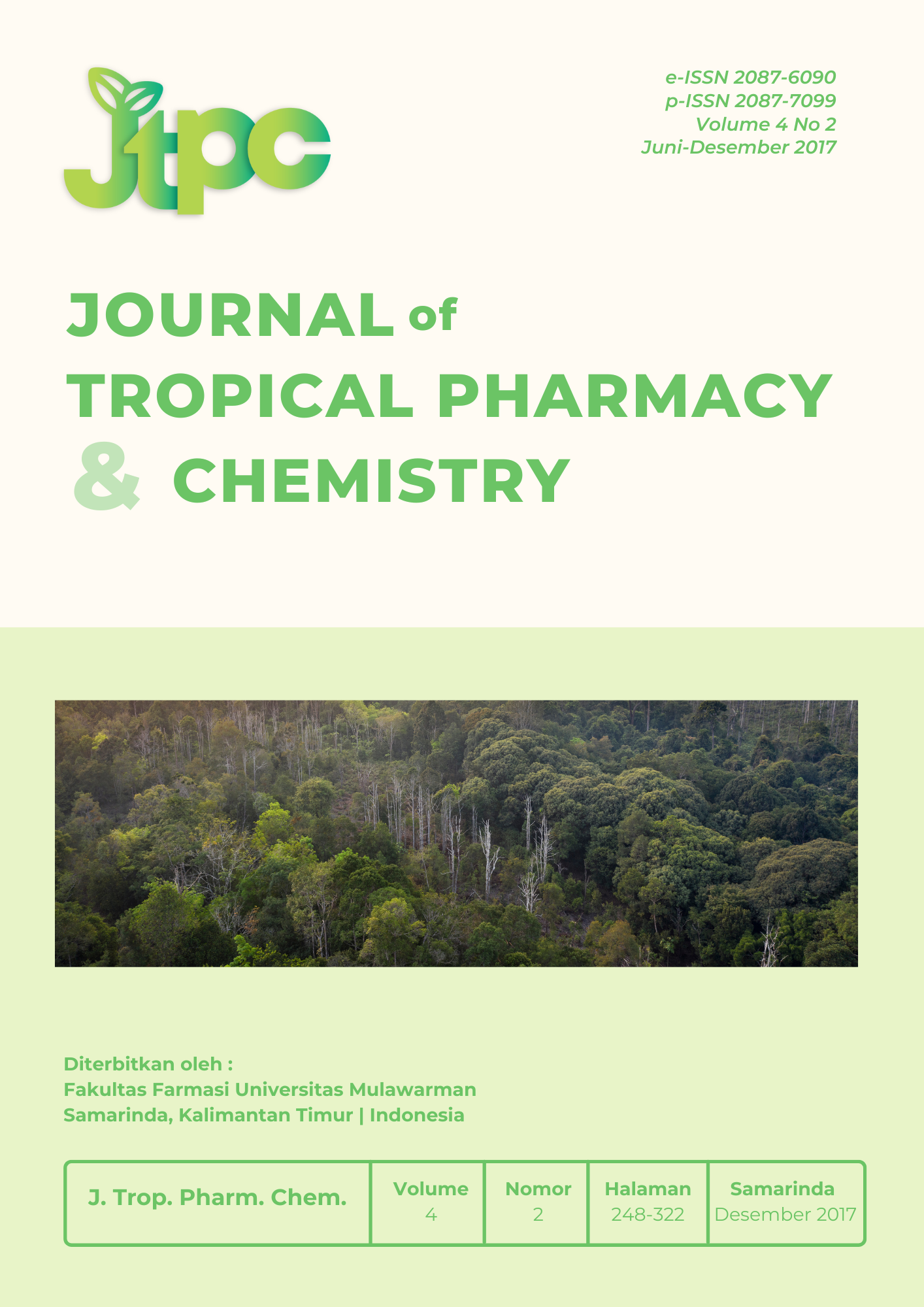Home / Archives / Vol. 4 No. 2 (2017): J. Trop. Pharm. Chem. / ArticlesPeran Homepharmacycare pada Pasien Diabetes Mellitus Tipe II Prolanis terhadap Tingkat Kepatuhan dan Keberhasilan Terapi Di BP Sentra Medika Lebaksiu Tegal
DOI:
https://doi.org/10.30872/j.trop.pharm.chem.v4i2.109Keywords:
diabetes mellitus, homepharmacycare, prolanis, compliance and successful therapy levelAbstract
Diabetes mellitus disease (DM) is chronic diseases due to the increase of glucose concentration in the body. The compliance and successful treatment of diabetes are needed to prevent complications. The patients’ compliance in using the medicine is an important factor of the successful therapy. One of the most comprehensive interventions for DM patients is Home Pharmacy Care. Objective: This study aims to determine the effect of Home Pharmacy Care role in patients with diabetes mellitus in increasing the compliance and successful therapy. Method: This research is pre experimental research conducted at Bp Sentra Medika Clinic and counseling at home respondents in Lebaksiu ,Tegal with using the method of one group pretest posttest design. Purposive sampling method is used in this research and got 35 respondents. Measurements were made using the MMAS-8 (pretest-postest) and pill count instrument to determine the patient's compliance level and the glucotest to measure the success of therapy characterized by blood sugar levels. Statistics test uses Wilcoxon and Mc Nemar to determine the effect of provision of Home Pharmacy Care intervention on compliace and successful therapy level. The results: showed that a total of 20 patients (57%) comliance to MMAS-8 and pill count scores and a total of 20 patients (57%) of successful treatment were achieved based on controlled blood glucose levels. Conslusion: The statistical test showed that there was a significant difference between before and after intervention marked with the value of p value of both tests was 0,000 so that there is an effect of giving Home Pharmacy Care toward the improvement of compliance and successful therapy.
Downloads
References
1. Aini, N., Fatmaningrum,W., dan Yusuf,A.(2011).Upaya meningkatkan perilaku pasien dalam tatalaksana diabetes melitus dengan pendekatan teori model behavioral system dorothy E. Johnson. Ners. Vol.6 (1)
2. Awad, N.,Yuanita, A., Karel, P.(2013). Gambaran Faktor Resiko Pasien Diabetes Mellitus Tipe II Di Poliklinik Endokrin Bagian/SMF FK-UNSRAT RSU Prof. Dr. R.D Kandou Manado Periode MEI 2011 –OKTOBER 2011. Jurnal e-Biomedik (eBM), Volume 1(1): 45-49
3. Badan POM RI. (2006). Kepatuhan Pasien : Faktor penting dalam keberhasian Terapi. Vol.7 (5)
4. Dinas kesehatan Provinsi Jawa Tengah.(2014).Profil kesehatan provinsi jawa tengah tahun 2014. Semarang
5. IDF.(2015). Atlas diabetes seventh edition. Vancouver. International Diabetes Federation. Website :http://www.diabetesatlas.org/
6. Info Diabetes Melitus. Data Statistik Jumlah Penderita Diabetes di Dunia versi WHO.(2012).Dipublikasikan 26 februari 2012.Website: http://indodiabetes.com/data-statistik-jumlah-penderita-diabetes-di-dunia-versi-who.html
7. Merentek, E.(2006). Resistensi Insulin Pada Diabetes Melitus Tipe 2. Cermin Dunia Kedokteran .(150)
8. Mulyani, R.(2016). Hubungan Kepatuhan dengan Keberhasilan Terapi Berbasis Kombinasi Insulin dan Obat Antidiabetik Oral pada Pasien Diabetes Mellitus Tipe 2 di Instalasi Rawat Jalan Rumah Sakit Umum Daerah Ulin Banjarmasin. Prosiding Rakernas dan Pertemuan Ilmiah Tahunan Ikatan Apoteker Indonesia
9. PERKENI.(2015).Konsensus Pengelolaan dan Pencegahan Diabetes Melitus Tipe 2 Di Indonesia 2015. PB Perkeni
10. Raditya,R.,dkk.(2015).Pengaruh pemberian Home care oleh apoteker pada pasien diabetes melitus. Jurnal Manajemen dan pelayanan Farmasi. Volume 5 (3)
11. Trisnawati, S & Setyogoro, S. (2013). Faktor Resiko Kejadian Diabetes Melitus Tipe II di Puskesmas Kecamatan Cengkareng Jakarta Barat Tahun 2012. Jurnal Ilmiah Kesehatan. Volume 5, No 1




